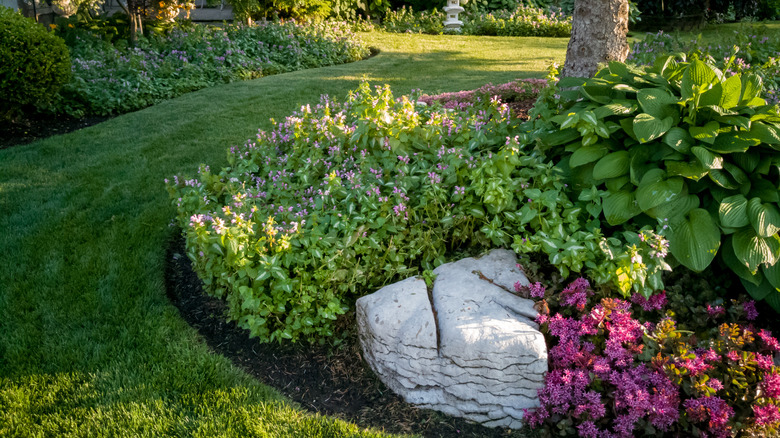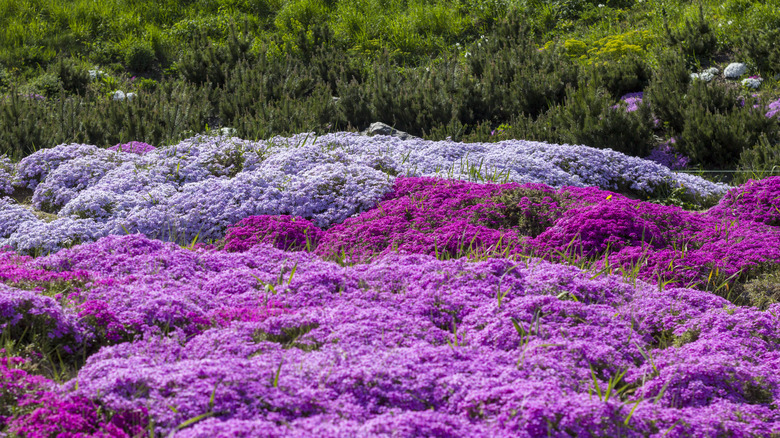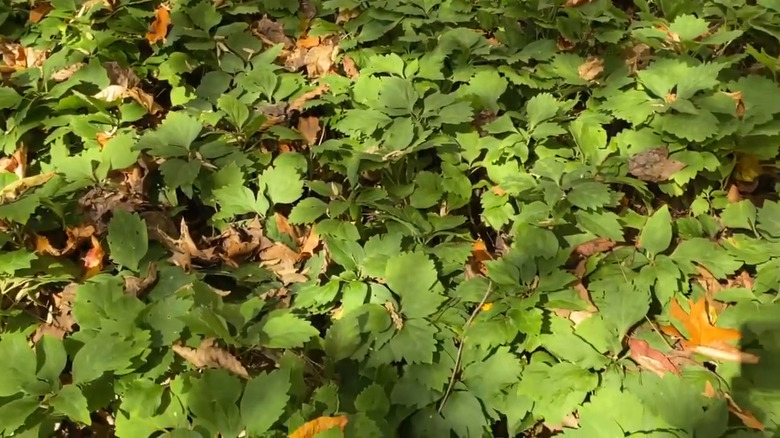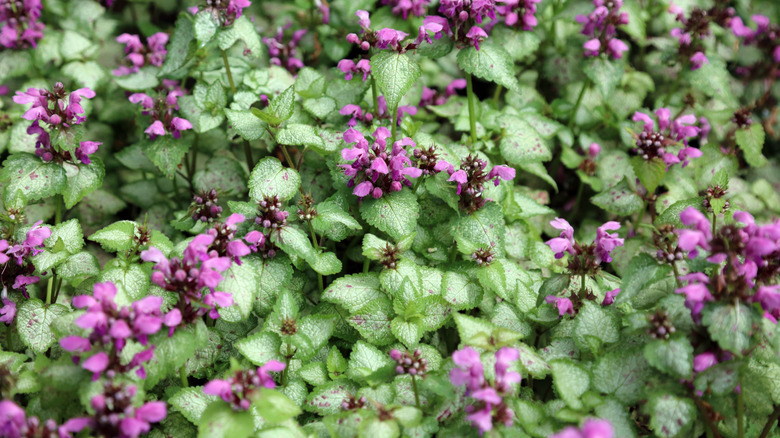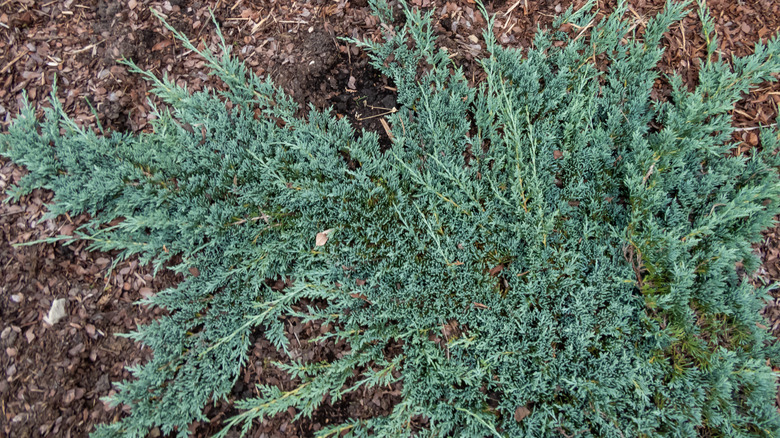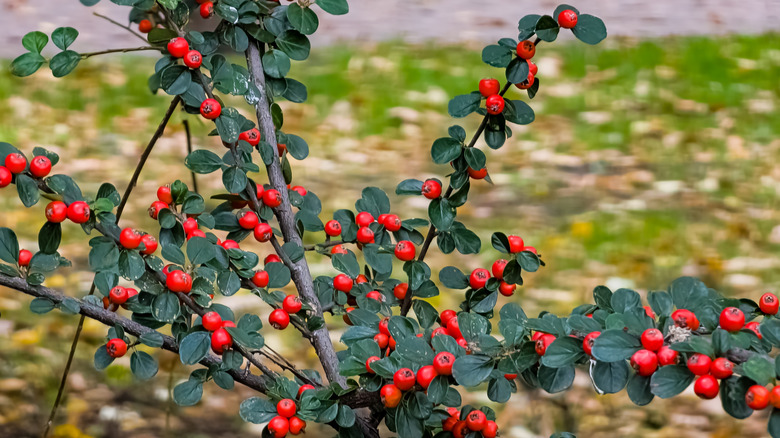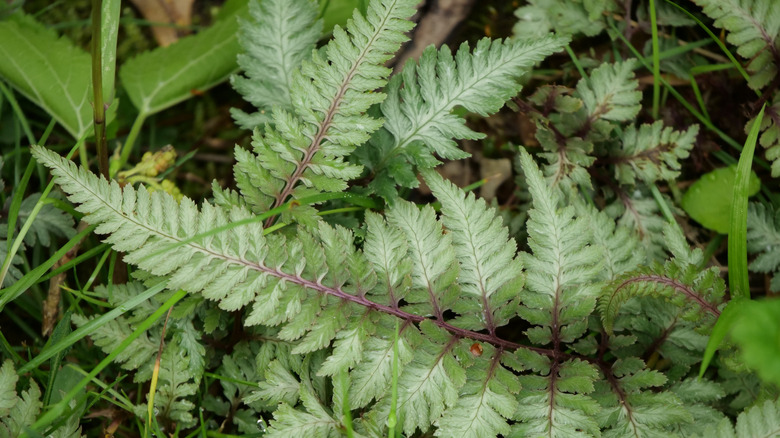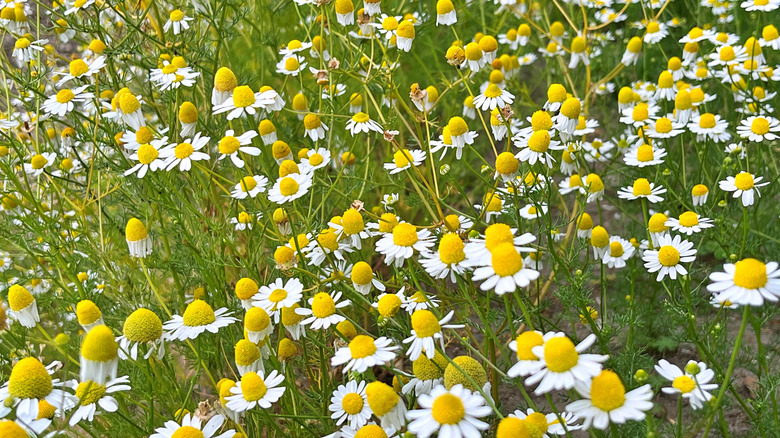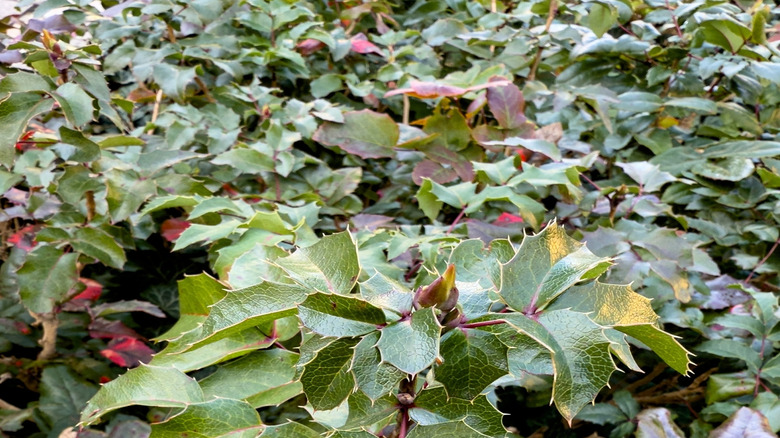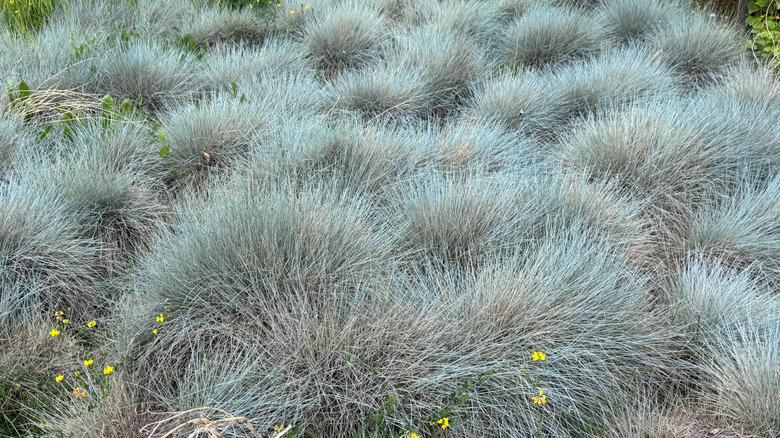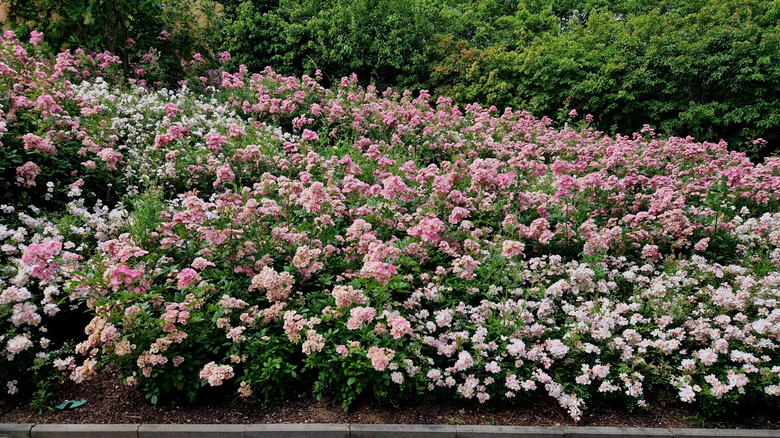20 Low-Maintenance Ground Covers You'll Adore For Their Little Care
Grass lawns aren't just one of the most popular ground covers; they're also one of the highest-maintenance plants in our yards. From frequent mowing and watering to fertilizing and reseeding, grass lawns eat up resources. While there's a lot to love about the lush expanse of a cool, green lawn, people are choosing eco-friendly grass alternatives in an effort to save time, money, and the environment. If you're looking for a more sustainable approach, then you'll appreciate this list of 20 low-maintenance ground covers and how little care they require.
Whether it's thirsty lawns or low-maintenance ground covers, the low-growing plants in our yards do a lot of heavy lifting in outdoor spaces, helping to prevent erosion and keep our yards neat and tidy. Whether you're looking for a ground cover that can replace your lawn or you have a challenging sunny slope or backyard shady area where grass won't grow, there are plants that can thrive in almost any condition, from USDA Hardiness Zones 2 to 11. Many of them require almost no care other than light weeding, infrequent watering, and the occasional mowing, and some of them last for years from a single planting.
From annuals and perennials to trees and shrubs, when planted en masse, almost any plant that forms a dense covering of vegetation can be considered a ground cover. However, to be considered low-maintenance, plants should not require regular, intensive maintenance once they are established.
Creeping phlox
One of the most significant problems with low-maintenance ground covers is that they can sometimes become invasive. Even some common ones, like pachysandra (Pachysandra terminalis) are listed as invasive in different parts of the country. Since native plants cannot be invasive, using native ground covers like creeping phlox (Phlox subulata) solves this problem. In zones 3 to 9, this perennial plant will be covered in a mat of pink, white, or purple flowers in the spring. Although it won't be as soft as your lawn, it is resistant to deer, drought, and wildfires.
Allegheny spurge
As mentioned, many people choose the popular Japanese pachysandra (Pachysandra terminalis) as a low-maintenance ground cover for shady areas. Another native to try instead is a close relative that comes from the southeastern United States, Allegheny pachysandra (Pachysandra procumbens). Allegheny pachysandra is easy to care for in zones 5 to 9, providing evergreen foliage in zones 7 and warmer. It grows well in the same areas as its Japanese cousin, under shady trees and in moist woodlands. Water deeply every week to two weeks to enjoy lush green growth for years.
Spotted deadnettle
One of the things that makes ground cover plants like English ivy (Hedera helix) and the periwinkles (Vinca major and V. minor) so appealing is that they're fast spreaders, covering large areas quickly and inexpensively. Unfortunately, that's also what makes them invasive, and what has given the next plant on our list a bit of a bad name. While some cultivars of lamium are invasive, others can be grown with care in your backyard, such as spotted deadnettle (Lamium maculatum). Several varieties of lamium make excellent ground cover plants in zones 3 to 8, especially in shady areas.
Lamb's ear
If silver color is what you're after, the striking foliage of lamb's ear (Stachys byzantina) is sure to please. Lamb's ear is named for its fuzzy, lamb-ear-shaped leaves, but don't let its cute appearance fool you — it's just as tough as it is charming. Although lamb's ear sends up flower stalks that can get up to 18 inches, this is a low-growing plant with dense foliage that usually stays under a foot tall. Like many perennials, lamb's ear does best if it's divided every few years, but it's remarkably easy to care for in zones 4 to 9.
Creeping thyme
This isn't the thyme you use in your kitchen, but it has the same fragrance and pollinator-friendly blooms. Not only is it a low-growing perennial that can tolerate everything from dry soils to foot traffic, creeping thyme (Thymus serpyllum 'Elfin') is one of the best plants for your pollinator garden. Hardy in zones 5 to 8, several low-maintenance cultivars can be grown for different colored blooms. Each plant spreads out to form a dense mat up to 6 inches tall. In mass plantings, this perennial can be pruned, sheared, or trimmed in late summer after it blooms.
Creeping juniper
Most people don't think of shrubs as ground covers, but creeping juniper (Juniperus horizontalis) is often used on slopes and retaining walls for exactly this purpose. Another North American native, this low-growing shrub forms dense mats up to 10 feet wide, reaching about 18 inches tall. Preferring sandy or rocky soils and sunny locations in zones 3 to 9, creeping juniper resists deer, heat, and drought. Since it lives for years once it's established, all you'll ever have to do is some light pruning of dead or diseased branches.
Rock cotoneaster
Rock cotoneaster (Cotoneaster horizontalis) is another good low-maintenance shrub for sunny slopes and retaining walls. Planted as a low-growing ground cover, rock cotoneaster has showy fruit and fall foliage in zones 5 to 7. When planting, you can space rock cotoneaster at about 4 to 5-foot intervals since it spreads up to 8 feet wide. While it can get 2 to 3 feet tall, it is a slow-growing shrub that may need some filler while it's getting established. Try pairing it with spring bulbs or perennial flowers until it fills in completely.
Bunchberry
Bunchberry (Cornus canadensis) is another native ground cover that can be grown as an alternative to invasive English ivy. If you're looking for a ground cover that's deer and rabbit-resistant for your zone 2 to 6 garden, bunchberry is a low-maintenance choice for areas with moist soil and partial shade. This charming low-growing shrub has white flowers and bright reddish-orange berries, and spreads by rhizomes to form dense carpets of woodland foliage. It's closely related to several larger dogwood shrubs like flowering dogwood (Cornus florida) and Siberian dogwood (Cornus alba).
Japanese painted fern
If low maintenance is your primary concern, Japanese painted ferns (Athyrium niponicum) are another good ground cover to consider. While many people choose ground covers for features like evergreen leaves, spreading growth habits, or flowers, the shade tolerance of Japanese painted ferns makes them a good choice for a gorgeous, healthy shade garden in zones 4 to 9. Taller than traditional ground covers at 2 feet tall, Japanese painted ferns get about as wide, completely covering entire areas when planted en masse. Several different colored cultivars are available, all requiring fertile, well-draining soil.
Hostas
Like ferns, most Hostas (Hosta spp.) are taller than traditional ground covers, but they fill the role nicely if you are looking for easy-to-care-for greenery in your backyard. Not all ground covers are grass alternatives, including hostas, which won't tolerate foot traffic and require a sheltered area. However, these are popular landscaping plants to grow, with thousands of different cultivars. Some of them are dwarf or miniature hostas from 4 to 6 inches. Hostas are easy to care for, provide flowers for visual interest and pollinators, and solve problems like erosion and bare, shaded patches where grass won't grow.
Stonecrop
There are several low growing sedum species that make excellent low-maintenance ground covers. Including common species like gold moss (Sedum acre 'Aureum') and blue spruce stonecrop (Sedum reflexum), sedums are generally hardy in zones 3 to 9 and tolerate a wide range of growing conditions. You can purchase a mixed sedum species mat from Lowe's for about $34 and use the drought-tolerant foliage as ground cover in sunny locations with well-drained soil. Sedum is also easy to propagate from divisions, or you can grow it from seed.
Blue star creeper
In zones 6 to 8, you can grow blue star creeper (Isotoma fluviatilis) as a low-maintenance ground cover for moist, shady areas. The name refers to the shape and color of the flowers, which are about ¼ inch in diameter and light blue. This is a broadleaf evergreen, often grown under taller plants in shade gardens. It spreads easily, although it can be contained with landscape edging. This makes it easy to propagate, but more importantly, this 3-inch-tall plant tolerates foot traffic. It does require occasional wet soil and partial shade, but is otherwise easy.
Creeping mazus
From the snapdragon family, creeping mazus (Mazus miquelli) is a low-maintenance grass alternative for zones 5 to 8. This is the ground cover you should grow instead of creeping Jenny (Lysimachia nummularia). Although they are both aggressive spreaders, creeping mazus is easy to contain with lawn edging. It's less than 3 inches tall with small tubular blue to purple flowers in the summer that offer a showy display. Creeping mazus is great for naturalized landscapes where you want something under 6 inches that tolerates foot traffic.
Kinnikinnick
Sometimes called bearberry or bear's grape, kinnikinnick (Arctostaphylos uva-ursi) is a low-maintenance ground cover for sandy soils in zones 3 to 7. Like many native plants, fertilization isn't recommended for kinnickinnick. Instead, most native plants do better as part of a naturalized landscape, where they can grow with as little care as possible. When mass plantings of bearberry are allowed to naturalize, they cover large areas at heights of 6 to 12 inches. This native ground cover provides nectar and fruit for wildlife, as well as dark green evergreen foliage for year-round visual interest.
Roman chamomile
There are two types of chamomile, a perennial one and an annual one, and people sometimes get them confused. Roman chamomile (Chamaemelum nobile) is the perennial one, and it's a drought-tolerant ground cover you can easily grow in your yard and garden. Hardy in zones 4 to 9, Roman chamomile gets about 1 to 2 feet tall when it produces daisy-like flowers that you can use for tea. The rest of the year, Roman chamomile creates a green mat of scented foliage that smells delicious when you walk on it.
Creeping mahonia
Whether you know it by creeping mahonia or Oregon grape, Mahonia repens is an evergreen shrub native to the western United States and hardy in zones 5 to 8. There are several related species in the genus, but Mahonia repens (reclassified as Berberis repens) is the one to use as a ground cover. While a taller relative, Mahonia aquifolium (Berberis aquifolium) commonly reaches 6 feet tall, Mahonia repens rarely reaches over a foot. Naturally resistant to deer, this native plant produces bright yellow flowers in the spring, followed by beautiful ornamental blue berries in the fall.
Box leaf honeysuckle
As we've seen with creeping juniper, rock cotoneaster, and kinnickinnick, some low-growing shrubs make excellent ground covers, offering low-maintenance greenery for years. Hardy in zones 6 to 8, the box leaf honeysuckle (Lonicera liplieata) only gets about 2 to 3 feet tall; however, it can spread up to 8 feet in diameter, offering plenty of ground coverage and weed suppression for your backyard areas. Deer-resistant and drought-tolerant, box leaf honeysuckle is versatile enough to grow in a variety of soils in full sun to partial shade.
Blue fescue
With thousands of species of grass to choose from, there are more than a few that can be considered low-maintenance ground covers. Cultivars like blue fescue 'Elijah Blue' (Festuca glauca 'Elijah Blue') can be included in mass plantings in a variety of landscape themes to add blue color, texture, and year-round interest to the garden. Requiring almost no care after being established, this low-maintenance grass won't provide the rough-and-tumble surface that a traditional lawn will, but it is easy to maintain in zones 4 to 9.
Ground cover roses
Low-growing roses can be an excellent ground cover solution in residential landscapes, especially on sunny slopes and other areas that don't need to be accessed frequently. Ground cover roses are a category that includes cultivars like Rosa 'Flower Carpet Coral' and Rosa 'Apricot Drift,' many of which are hardy in zones 4 to 11. In zones 2 and 3, even hardier shrub rose varieties that get about 2 feet tall can be used as low-maintenance ground covers, including cultivars like Rosa 'Simon Fraser.'
Greek oregano
A plant that follows the sustainable gardening trend we hope to see dominate in 2026, oregano (Origanum spp.) is right at home in edible landscapes and backyard food forests. Many species of oregano can be used as ground cover in the yard and garden, but the true Greek oregano (Origanum vulgare x hirtum) is the most well-known for culinary uses. All oregano cultivars grow in poor, dry soils with very little care. Not only are they drought-tolerant, but they also resist deer, rabbits, and insect pests.
